Lintneria maura
|
|
Updated as per
AN ANNOTATED CHECKLIST OF THE SPHINGIDAE OF BOLIVIA, October 2007
Updated as per the L.O.L.A. publication Hawkmoths of Argentina, More,
Kitching and Cocucci, 2005, October 2007.
Updated as per personal communication with Dr. Carlos Marzano (Villa Amancay, Cordoba, Argentina, December 21, 2008), December 31, 2008
Updated as per personal communication with Nigel Venters (Tafe de Valle, Tucuman, Argentina, November 26, 2008, 2000m), February 12, 2009
Updated as per The Hawk Moths of the North America, 2007, James P. Tuttle (Sphinx to Lintneria); April 2009
Updated as per personal communication with Ezequiel Bustos (Shilap revta. lepid. 43 (172) diciembre, 2015, 615-631 eISSN 2340-4078 ISSN 0300-5267), January 4, 2016
|
Lintneria maura
(Burmeister, 1879) Sphinx
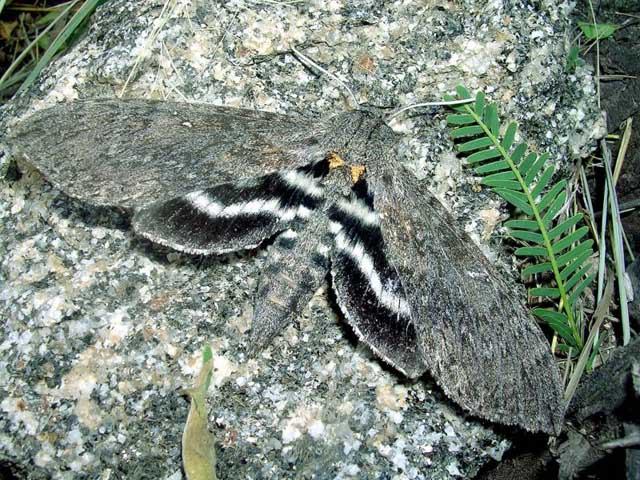
Lintneria maura, Amancay, Cordoba, Argentina,
December 2008, courtesy of Dr. Carlos Marzano.
This site has been created by
Bill Oehlke at oehlkew@islandtelecom.com
Comments, suggestions and/or additional information are welcomed by Bill.
TAXONOMY:
Family: Sphingidae, Latreille, 1802
Subfamily: Sphinginae, Latreille, 1802
Tribe: Sphingini, Latreille, 1802
Genus: Lintneria Butler, 1876 ...........
Species: maura Burmeister, 1879
|
MIDI MUSIC
.....It's a Wonderful World.....
copyright C. Odenkirk
ON.OFF
<bgsound src="world.mid" LOOP=FOREVER>
|
DISTRIBUTION:
Lintneria maura
(Wing span: approximately 80mm) flies in
Argentina: Catamarca, Cordoba, Jujuy, Los Rios, Salta, Tucuman (2000m);
and
Bolivia: La Paz (1900m), Santa Cruz (450m).
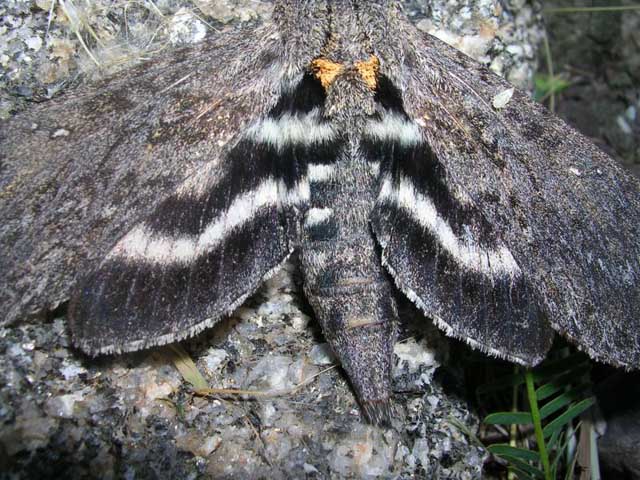
Lintneria maura, Amancay, Cordoba, Argentina,
December 2008, courtesy of Dr. Carlos Marzano.
In his The Hawk Moths of North America, 2007, James P. Tuttle has assigned all the
Sphinx genus species from Mexico south throughout South American to Lintneria, Butler, 1876, based on
consistent differences in wing characters and significant larval differences.
FLIGHT TIMES:
Lintneria maura adults
fly from May into October in Bolivia at elevations up to 1900m.
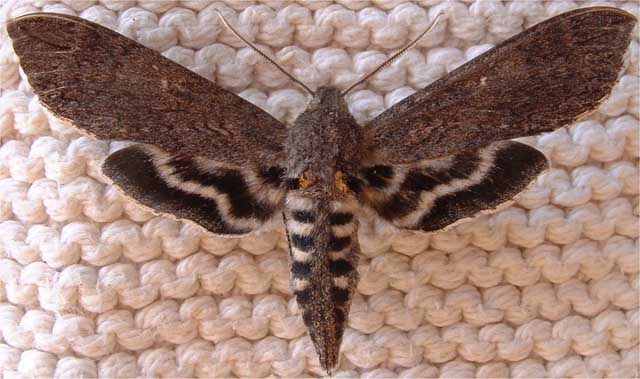
Sphinx maura, Tafe de Valle, Tucuman, Argentina,
wingspan: 80mm, November 26, 2008, 2000m, courtesy of Nigel Venters.
They have been reported from Argentina in November-December at elevations up to 2000m.
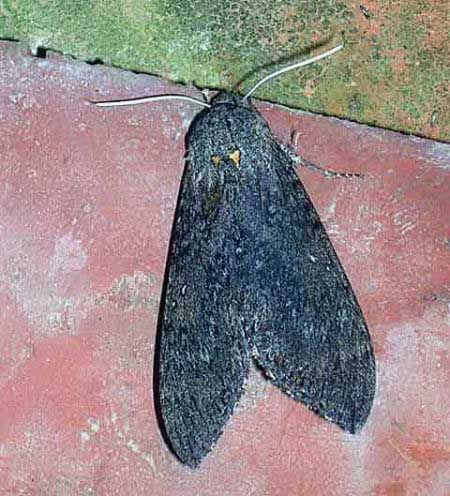
Lintneria maura, Amancay, Cordoba, Argentina,
December 2008, courtesy of Dr. Carlos Marzano.
Dr. Carlos Marzano confirms a December flight in Cordoba, Argentina.
Specimens have been taken at elevations of 384-1471m in October, November, December and February in Argentina.
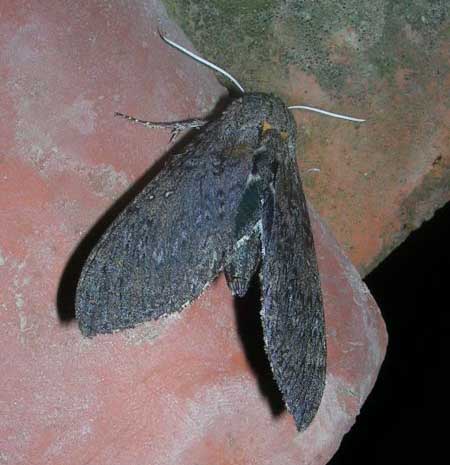
Lintneria maura, Amancay, Cordoba, Argentina,
December 2008, courtesy of Dr. Carlos Marzano.
ECLOSION:
Pupae probably wiggle to surface from
subterranean chambers just prior to eclosion.
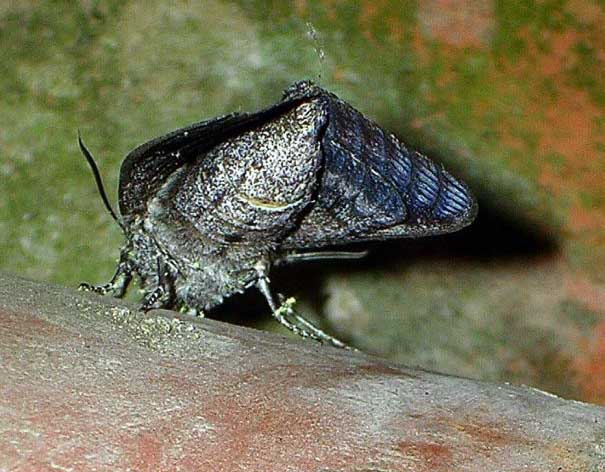
Lintneria maura, Amancay, Cordoba, Argentina,
December 2008, courtesy of Dr. Carlos Marzano.
SCENTING AND MATING:
Females call in the males with a
pheromone released from a gland at the tip of the
abdomen. Adults probably nectar at a variety of flowers.
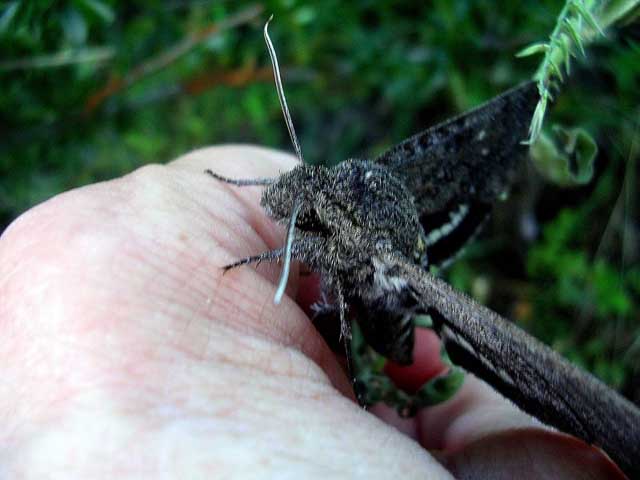
Lintneria maura, Amancay, Cordoba, Argentina,
December 2008, courtesy of Dr. Carlos Marzano.
EGGS, LARVAE, PUPAE:
Please visit my special request for images of Lintneria species larvae at
Lintneria larvae, and help if you can.
It is anticipated that the Lintneria larvae will most often be encountered on Lamiaceae: Salvia (Sage), Mentha (Mints), Monarda (Beebalm) and
Hyptis (Bushmints); Verbenaceae: Verbena and Lantana camara (shrub verbenas or lantanas).
Although they may be encountered feeding during daylight hours, one is even more likely to discover them feeding in the evening or after dark.
Two of the greatest clues for discovering larvae are stripped foliage and droppings beneath the plant. You might be quite surprised at what will turn up in the evening or
after dark in a flashlight assisted search.
It is believed that all "Lintneria larvae will exhibit "a fleshy thoracic dorsal "horn" in the first 4 instars (unique in the Sphingidae of the world to my
knowledge) which is replaced by a thoracic dorsal "hump" with a large black patch in the 5th instar." J.A. Tuttle.
Use your browser "Back" button to return to the previous page.
Return to Sphingidae Index
Return to Sphingini Tribe
Use your browser "Back" button to return to the previous page.
This page is brought to you by
Bill Oehlke and the
WLSS. Pages are on space rented from Bizland. If you would like
to become a "Patron of the Sphingidae Site", contact Bill.
Please send sightings/images to Bill. I will do my best to respond to
requests for identification help.
Enjoy one of nature's wonderments: Live
Saturniidae (Giant Silkmoth) cocoons.
 | 
Show appreciation for this site by clicking on flashing butterfly to the left.
The link will take you to a page with links to many insect sites. |








